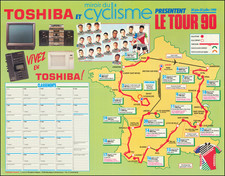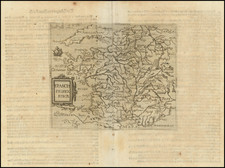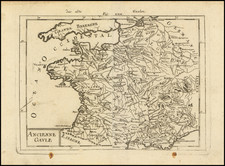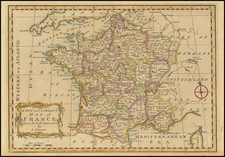Striking view of the City of Belle, from Blaeu's Novum Ac Magnum Theatrum Urbium Belgicae.
Belle the subject of repeated invasions in the seventeenth century by Spanish and French troops until it was added to France in 1678.
Blaeu produced this map during the period between the end of the Twelve Year Truce between the United Provinces and Spain and the official ending of the eighty year war and recognition of the United Provinces as an independent state by the Spanish royal house. After the Truce, it became apparent Spain would not re-conquer the seven northern provinces. The truce had deepened the cultural and political gap between the northern and the southern provinces, which had become more and more pro-Spanish.
Frustrations about the southern attitude to the conflict, political tensions within the United Provinces, a desire to re-conquer what had been lost, and the appearance of France as a new contestant on the battle field in the southern provinces led to a new upheaval in hostilities and stimulated an interest in the United Provinces in key positions in contested over areas, military bases and old as well as new battle sites, as we see reflected in the depictions on Blaeu's maps.
Joan, or Johannes, Blaeu (1596-1673) was the son of Willem Janszoon Blaeu. He inherited his father’s meticulous and striking mapmaking style and continued the Blaeu workshop until it burned in 1672. Initially, Joan trained as a lawyer, but he decided to join his father’s business rather than practice.
After his father’s death in 1638, Joan and his brother, Cornelis, took over their father’s shop and Joan took on his work as hydrographer to the Dutch East India Company. Joan brought out many important works, including Nova et Accuratissima Terrarum Orbis Tabula, a world map to commemorate the Peace of Westphalia which brought news of Abel Tasman’s voyages in the Pacific to the attention of Europe. This map was used as a template for the world map set in the floor of the Amsterdam Town Hall, the Groote Burger-Zaal, in 1655.
Joan also modified and greatly expanded his father’s Atlas novus, first published in 1635. All the while, Joan was honing his own atlas. He published the Atlas maior between 1662 and 1672. It is one of the most sought-after atlases by collectors and institutions today due to the attention to the detail, quality, and beauty of the maps. He is also known for his town plans and wall maps of the continents. Joan’s productivity slammed to a halt in 1672, when a fire completely destroyed his workshop and stock. Joan died a year later and is buried in the Westerkerk in Amsterdam.












![[English Channel] A New Gradnally Encreassnig Compass-map of the Comingin of the Channel, or the Heads; containing a part of the coast of Boulonnois; extending from Callis to Dannes, as also in England, from the South Foreland to Rye; with their S'hallownesses and Depths By N. deVries](https://storage.googleapis.com/raremaps/img/small/85127.jpg)

![(France) Gallia Antiqua Ex Aevi Romani Monumentis Eruta et Serenissimi Carnutum Ducis Munificentia Publici Juris Facta [Ancient Gaul From the Roman Age, the erudite Monuments. . .]](https://storage.googleapis.com/raremaps/img/small/82019.jpg)